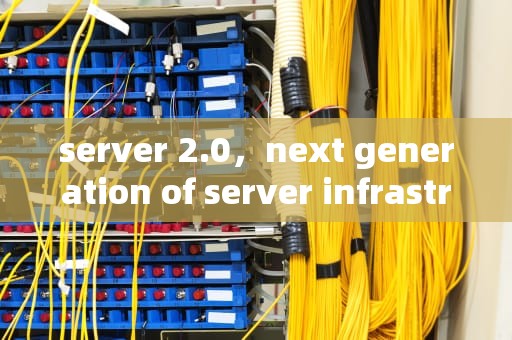本文目录导读:

In the rapidly evolving world of technology, the server industry is undergoing a transformative shift. The traditional server infrastructure, which has dominated computing for decades, is now facing increasing pressure to adapt to the demands of modern applications. This article explores the concept of "server 2.0," a new generation of server infrastructure that is designed to be more efficient, scalable, and aligned with the needs of the digital age.
Traditional server infrastructure has been the backbone of computing for decades. However, as applications become more complex and demanding, traditional servers are struggling to meet the growing requirements. Key limitations include:
High Latency: Traditional servers often suffer from high latency, which can be a significant bottleneck for applications that require low-latency processing, such as real-time analytics or online gaming.
Energy Consumption: The high power draw of traditional servers contributes to significant energy costs, which is a growing concern as the environmental impact of computing becomes more prominent.
Scalability Challenges: While traditional servers are designed to scale, they often struggle to do so efficiently. Adding more servers to handle increased load can be costly and may not always lead to linear performance improvements.
Complexity: As applications become more complex, managing traditional servers becomes increasingly difficult. The need for containerization, orchestration, and microservices has become more apparent.
Server 2.0 represents a fundamental shift in how servers are designed and operated. It is not just an upgrade to existing infrastructure but a complete rethinking of what servers are and how they function. Key characteristics of server 2.0 include:
Distributed Architecture: Server 2.0 is built on a distributed architecture, where computation is decentralized across multiple nodes. This eliminates the single point of failure and improves scalability and resilience.
Containerization: Server 2.0 embraces containerization as a core technology. Containers allow applications to run in isolated environments, making it easier to manage and scale applications.
AI and Machine Learning Support: Server 2.0 is designed to work seamlessly with AI and machine learning algorithms. This enables real-time decision-making, predictive analytics, and automated optimization.
Green Energy Management: Server 2.0 places a strong emphasis on energy efficiency. Advanced technologies such as thermoelectric cooling and smart power management are being used to reduce energy consumption.
Server 2.0 is already being implemented in a variety of industries, from cloud computing to manufacturing. Here are some examples:
Cloud Computing: AWS's serverless architecture is a prime example of server 2.0 in action. By automatically scaling resources based on demand, serverless computing eliminates the need for traditional server management.
Edge Computing: Server 2.0 is also being applied in edge computing, where servers are placed closer to the end-users to reduce latency. This is particularly important for applications like autonomous vehicles and industrial IoT.
AI-Driven Applications: Server 2.0 is at the heart of AI-driven applications. By providing the computational power needed for training and running machine learning models, server 2.0 enables real-time decision-making.
IoT: The proliferation of IoT devices is driving the adoption of server 2.0. These devices generate vast amounts of data, and server 2.0 provides the scalable infrastructure needed to process and analyze this data.
As server 2.0 continues to evolve, it is expected to play a key role in shaping the future of computing. Some key trends to watch include:
Integration with Edge Computing: Server 2.0 will become increasingly integrated with edge computing, enabling faster and more efficient processing of data.
AI and Machine Learning Integration: The use of AI and machine learning in server infrastructure will continue to grow, with servers becoming more intelligent and self-managing.
Green Energy Management: As the demand for energy-efficient computing grows, server 2.0 will play a key role in reducing energy consumption.
Edge-to-Cloud Connectivity: Server 2.0 will enable seamless connectivity between edge servers and cloud servers, allowing for more flexible and efficient resource management.
Server 2.0 represents a fundamental shift in how servers are designed and operated. By embracing distributed architecture, containerization, AI and machine learning, and energy efficiency, server 2.0 is transforming the way we think about computing. As the demand for scalable, efficient, and intelligent server infrastructure grows, server 2.0 will play a key role in shaping the future of technology. Whether it's in cloud computing, edge computing, or IoT, server 2.0 is here to stay and will continue to drive innovation in the years to come.
随着互联网的普及和信息技术的飞速发展台湾vps云服务器邮件,电子邮件已经成为企业和个人日常沟通的重要工具。然而,传统的邮件服务在安全性、稳定性和可扩展性方面存在一定的局限性。为台湾vps云服务器邮件了满足用户对高效、安全、稳定的邮件服务的需求,台湾VPS云服务器邮件服务应运而生。本文将对台湾VPS云服务器邮件服务进行详细介绍,分析其优势和应用案例,并为用户提供如何选择合适的台湾VPS云服务器邮件服务的参考建议。

工作时间:8:00-18:00
电子邮件
1968656499@qq.com
扫码二维码
获取最新动态
